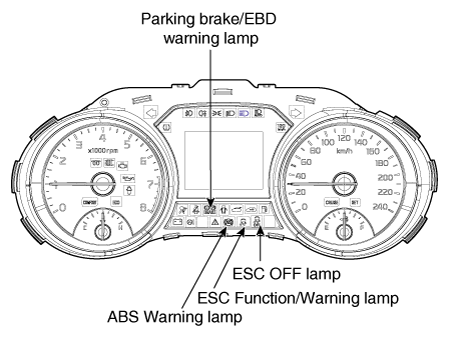Kia Picanto: Brake System / ESC (Electronic Stability Control) System
Kia Picanto JA 2017-2025 Service & Repair Manual / Brake System / ESC (Electronic Stability Control) System
Components and components location
| Components |
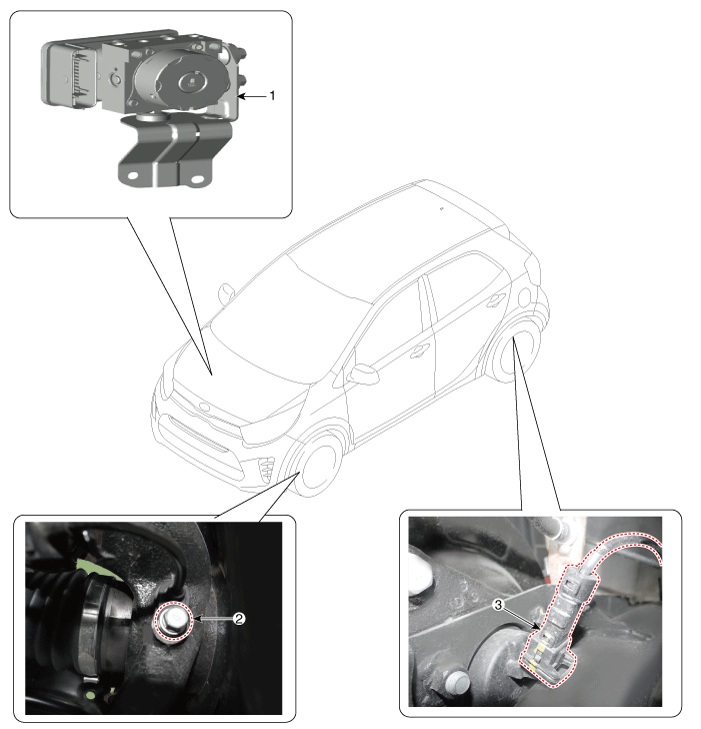
| 1. ESC control module (HECU) 2. Front wheel speed sensor | 3. Rear wheel speed sensor |
Description and operation
| Description of ESC |
Electronic
Stability Control (ESC) recognizes critical driving conditions, such as
panic reactions in dangerous situations, and stabilizes the vehicle by
wheel-individual braking and engine control intervention.
ESC
adds an additional function known as Active Yaw Control (AYC) to the
ABS, TCS, EBD and ESC functions. On contrary, the ABS/TCS function
controls wheel slip during braking and accelerating, and thus, mainly
intervenes in the longitudinal dynamics of the vehicle, and the active
yaw control stabilizes the vehicle on the vertical axis.
This
is achieved by wheel individual brake intervention and adaptation of
the momentary engine torque with no need for any action to be taken by
the driver.
ESC essentially consists of three assemblies : the sensors, the electronic control unit and the actuators.
The
stability control feature works under all driving and operating
conditions. Under certain driving conditions, the ABS/TCS function can
be activated simultaneously with the ESC function in response to a
command by the driver.
In the event of a failure of the stability control function, the basic safety function, ABS, is still maintained.
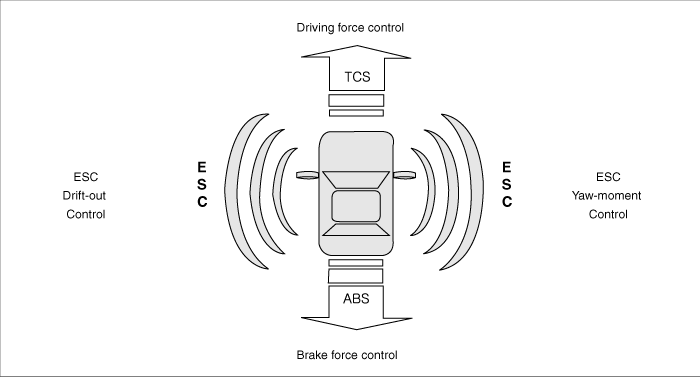
Description of ESC Control
ESC system consists of ABS/EBD, TCS and AYC functions.
ABS/EBD
function : The ECU changes the active sensor signal (current shift)
coming from the four wheel sensors into square waves. By using the input
of above signals, the ECU calculates the vehicle speed and the
acceleration & deceleration of the four wheels. And, the ECU judges
whether the ABS/EBD should be actuated or not.
TCS
function prevents the wheel slip of drive direction by adding the brake
pressure and engine torque reduction via CAN communication. TCS
function uses the wheel speed sensor signal to determine the wheel slip
as far as ABS function.
AYC
function prevents unstable maneuver of the vehicle. To determine the
vehicle maneuver, AYC function uses the maneuver sensor signals (Yaw
Rate Sensor, Lateral Acceleration Sensor, and Steering Wheel Angle
Sensor).
If
vehicle maneuver is unstable (Over Steer or Under Steer), AYC function
applies the brake pressure on certain wheel, and sends engine torque
reduction signal by CAN.
After
the key-on, the ECU continuously diagnoses the system failure
(self-diagnosis). If the system failure is detected, the ECU informs
driver of the system failure through the BRAKE/ABS/ESC warning lamp
(fail-safe warning).
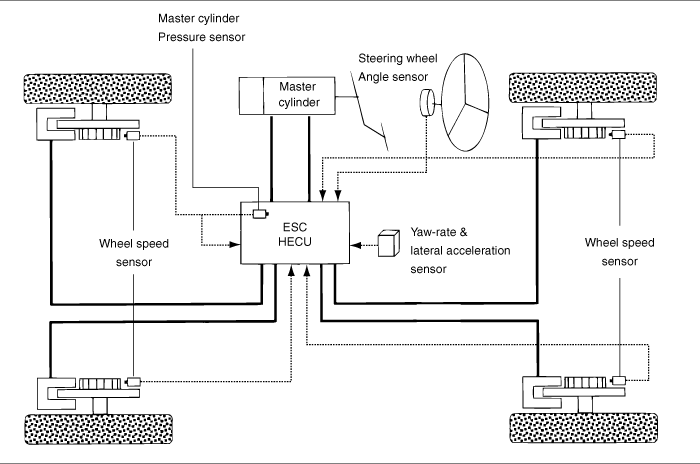
Input and Output Diagram
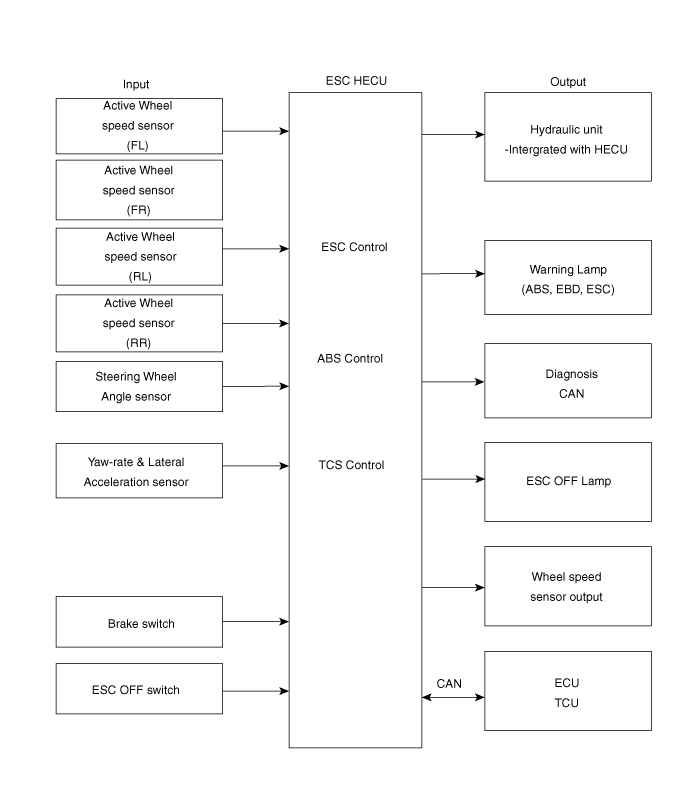
| ESC Operation Mode |
| ESC Hydraulic System Diagram |
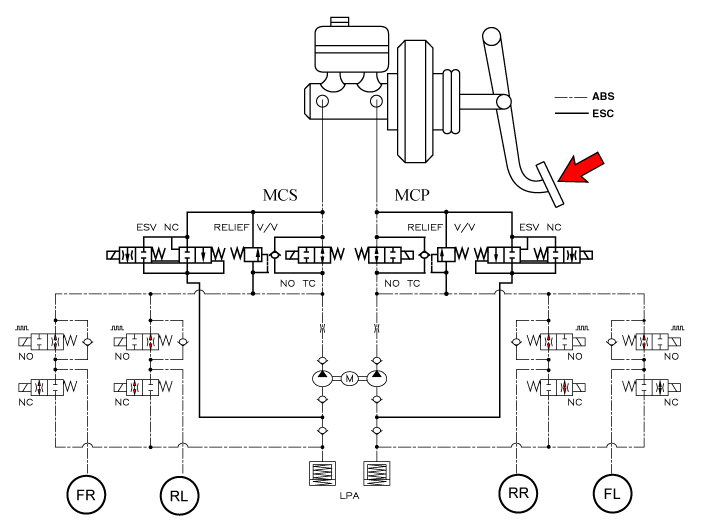
| 1. | ESC Non-operation : Normal braking.
|
| 2. | ESC operation
| ||||||||||||||||||||||
ABS Warning Lamp module
The
active ABS warning lamp module indicates the self-test and failure
status of the ABS. The ABS warning lamp is turned on under the following
conditions:
| – | During the initialization phase after IGN ON. (continuously 3 seconds). |
| – | In the event of inhibition of ABS functions by failure. |
| – | During diagnostic mode. |
| – | When the ECU Connector is seperated from ECU. |
| – | Cluster lamp is ON when communication is impossible with CAN module. |
EBD/Parking Brake Warning Lamp Module
The
active EBD warning lamp module indicates the self-test and failure
status of the EBD. However, in case the Parking Brake Switch is turned
on, the EBD warning lamp is always turned on regardless of EBD
functions. The EBD warning lamp is turned on under the following
conditions:
| – | During the initialization phase after IGN ON. (continuously 3 seconds). |
| – | When the Parking Brake Switch is ON or brake fluid level is low. |
| – | When the EBD function is out of order . |
| – | During diagnostic mode. |
| – | When the ECU Connector is seperated from ECU. |
| – | Cluster lamp is ON when communication is impossible with CAN module. |
ESC Function/Warning Lamp
The ESC function/warning lamp indicates the self-test and failure status of the ESC.
The ESC function/warning lamp is turned on under the following conditions:
| – | During the initialization phase after IGN ON. (continuously 3 seconds). |
| – | When the ESC function is inhibited by system failure. |
| – | When the ESC control is operating. (Blinking - 2Hz) |
| – | During diagnostic mode.(Except standard mode) |
| – | Cluster lamp is ON when communication is impossible with CAN module. |
ESC Off Lamp
The ESC Off lamp indicates the self-test and operating status of the ESC.
The ESC Off lamp operates under the following conditions :
| – | During the initialization mode after IGN ON. (continuously 3 seconds). |
| – | ESC Off lamp is On when driver input the ESC Off switch. |
ESC On/Off Switch
The ESC On/Off Switch is used to toggle the ESC function between On/Off states based upon driver input.
The On/Off switch is a normally open, momentary contact switch. Closed contacts switch the circuit to ignition.
Initial status of the ESC function is on and switch toggle state.
- ESC Control Module
- Front Wheel Speed Sensor
- Rear Wheel Speed Sensor
- ESP OFF Switch
- Emergency Signal System
 Rear Wheel Speed Sensor
Rear Wheel Speed Sensor
Repair procedures
Removal
1. Remove the wheel tire (A).
Tightening torque:
107.9 - 127.5 N·m (11.0 - 13.0 kgf·m, 79.6 - 94.0 lb·ft)
2. Remove the luggage side trim.
...
 ESC Control Module
ESC Control Module
Components and components location
Components
1. ESC control module connector 2. ESC control module 3. ESC bracket
Repair procedures
Removal
1.Turn ignition OFF and disconnec ...
Other information:
Kia Picanto JA 2017-2025 Owner's Manual: Tire specification and pressure label, Engine number, Air conditioner compressor label
Tire specification and pressure label The tires supplied on your new vehicle are chosen to provide the best performance for normal driving. The tire label located on the driver's side center pillar gives the tire pressures recommended for your car. Engine number The engine number is ...
Kia Picanto JA 2017-2025 Owner's Manual: System operation
Ventilation 1. Set the mode to the position. 2. Set the air intake control to the outside (fresh) air position. 3. Set the temperature control to the desired position. 4. Set the fan speed control to the desired speed. Heating 1. Set the mode to the position. 2. Set the air intake con ...
Copyright © www.kpicanto.com 2017-2025


